 |
 |
 |
| |
CD4+ Cell Increases at 48 Weeks in the Maraviroc Treatment-naive MERIT Trial
|
| |
| |
Reported by Jules Levin
ICAAC/IDSA Oct 28 2008 Wash DC
A Lazzarin1, M Battegay2, DA Cooper3, JG Sieera-Madero4, JB Angel5, I Frank6 R Wood7, JM Goodrich8, J Heera8, N Rajicic9, R Tressler9, H Valdez9 and H Mayer8
1San Raffaele Scientific Institute, Milan Italy; 2Universitatsspital Basel, Switzerland; 3University of New South Wales, Sydney, Australia; 4Instituto Nacional de Ciencias Médicas y Nutrición Salvador Zubirán, Mexico City, Mexico; 5University of Ottawa, Canada; 6University of Pennsylvania, Philadelphia, USA; 7The Desmond Tutu HIV Centre, Observatory, South Africa; 8Pfizer Global Research and Development, New London, USA; 9Pfizer Inc, New York, USA
AUTHOR CONCLUSIONS
In the MERIT study, treatment-naive patients receiving MVC + CBV experienced early, rapid, and persistently greater CD4+ cell count increases vs those receiving EFV + CBV through Week 48 (P=0.004).
The percentage of patients with a discordant immunologic response to study treatment was lower with MVC + CBV than with EFV + CBV.
An early, rapid but transient CD8+ cell count rise was observed with MVC + CBV, while with EFV + CBV CD8+ cell count declined between baseline and Week 48.
MVC + CBV was associated with a larger increase in CD4+ cell count than EFV + CBV, even after adjusting for change in HIV-1 RNA.
Higher on-treatment CD4+ cell counts were associated with a longer time to Category C event occurrence.
This supports the premise that the additional CD4+ cells conferred by MVC + CBV were functional, and suggests that antagonism of the CCR5 co-receptor by MVC was not associated with any deleterious effect as measured by Category C events at 48 weeks.
Among patients who did not achieve an undetectable viral load, MVC + CBV recipients had a significantly lower risk of developing a Category C event, and experienced significantly greater CD4+ cell count increases compared to EFV + CBV recipients.
"among patients who did not achieve HIV-1 RNA <50 copies/mL at Week 48, fewer MVC recipients (1/104 [1%]) developed a Category C event compared to EFV recipients (7/75 [9%]; P=0.007). The median (IQR) CD4+ cell count changes from baseline in these non-responder subgroups were 64 (4.5, 142.5) and 0 (-7.75, 76.5) cells/mm3, respectively."
BACKGROUND
Treatment-induced increases in CD4+ cell count are associated with clinical benefits beyond decreasing the occurrence of AIDS-defining illnesses:
Mortality rates for AIDS-defining malignancies (ADM) were 20.1 vs 0.1 per 1,000 patient-years and for non- ADM were 6.0 vs 0.6 per 1,000 patient-years when the current CD4+ cell count was <50 vs >500 cells/mm3, respectively.1
HIV-infected adults who achieve CD4+ cell counts of >/=500 cells/mm3 for >/=6 years have a survival rate similar to that of HIV-negative individuals.2
Immunologic response to HAART in previously ARV-naive patients has been shown to be an important predictor of clinical outcome regardless of virologic response.3
A lack of immunologic response 3-9 months after HAART initiation in patients who respond virologically has been shown to be significantly associated with earlier development of an opportunistic infection or death.4
In the CPCRA FIRST trial, following initiation of HAART and after a median follow-up of 5 years, each 100 cell/mm3 higher CD4+ cell count during follow-up was independently associated with a 14% lower risk for non-AIDS diseases (liver disease, cardiovascular disease, renal disease, and non-ADM).5 A poor initial CD4+ recovery (<50 or 100 cells/mm3 after 8 months of virologically effective HAART), was associated with increased risk for a composite outcome of AIDS, non-AIDS disease, or death.6
The MERIT study is an ongoing, randomized, double-blind study designed to compare the safety and efficacy of maraviroc (MVC; marketed as Celsentri/Selzentry) 300 mg BID vs efavirenz (EFV) 600 mg QD, both administered with Combivir (CBV; a fixed-dose combination of zidovudine and lamivudine), in treatment-naive patients with R5 HIV-1 (Trofile assay, Monogram Biosciences, South San Francisco, CA).
As previously presented,7 analysis of Week 48 data demonstrated that 65% of patients receiving MVC achieved an HIV-1 RNA level of <50 copies/mL compared to 69% for EFV.7 More patients discontinued from MVC for lack of efficacy compared to EFV (11.9% vs 4.2%), whereas fewer patients discontinued MVC due to adverse events (4.2% vs 13.6%).7
OBJECTIVES
The objectives of these post-hoc analyses are:
To describe CD4+ cell count increases through 48 weeks and the incidence of discordant virologic-immunologic responses after 6 months in treatment-naive patients receiving MVC or EFV in the MERIT study.
To identify predictors of CD4+ cell count increases in treatment-naive patients receiving MVC vs EFV.
To identify factors associated with the development of Category C (AIDS-defining) events.
METHODS
The design of the MERIT study has been presented previously.7
For this post-hoc analysis, missing CD4+ cell count values were handled using a method of last observation carried forward (LOCF).
Data summaries and statistical analyses
⋅ Descriptive summaries.
⋅ Comparison of frequency distributions of concordant and discordant immunologic and virologic responses using a Pearson's chi-squared test.
⋅ Summary of number of patients exceeding clinically meaningful CD4+ cell count thresholds.
⋅ Repeated-measures model of CD4+ cell counts over time that included treatment arm and visit, with interaction, as model terms.
⋅ A multivariate regression model of Week 48 CD4+ cell count change from baseline that included baseline CD4+ cell count and HIV-1 RNA level, Week 48 HIV-1 RNA change from baseline, age, gender, and treatment arm as model predictors.
⋅ A Cox proportional hazard regression model to analyze time to Category C event, using baseline CD4+ cell count, baseline HIV-1 RNA level, time-adjusted CD4+ cell count, achieving HIV-1 RNA <50 copies/mL by week 48, age, gender, and treatment arm as variables.
RESULTS
Baseline characteristics of the MERIT study population are summarized in Table 1.
Significantly greater and faster increases in CD4+ cell count were observed in patients receiving MVC compared to EFV (Figure 1).
The median (IQR) change from baseline in CD4+ cell count at Week 48 was +151 (+76, +236) cells/mm3 in the MVC arm compared to +122 (+54, +204) cells/mm3 in the EFV arm (P=0.002).
The difference between treatment arms in CD4+ cell counts responses was apparent as early as Week 4, when patients in the MVC arm had experienced a median (IQR) change from baseline of +77 (+24, +130) cells/mm3 compared to +47 (0, +111) cells/mm3 for patients in the EFV arm (P=0.0001).
79% of patients receiving MVC who started the trial with <200 CD4+ cells/mm3 achieved >/=200 cells/mm3 by Week 48, compared to 71% of patients receiving EFV (Figure 2).
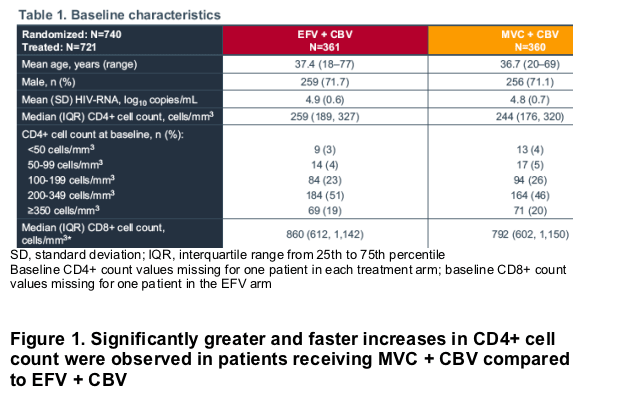
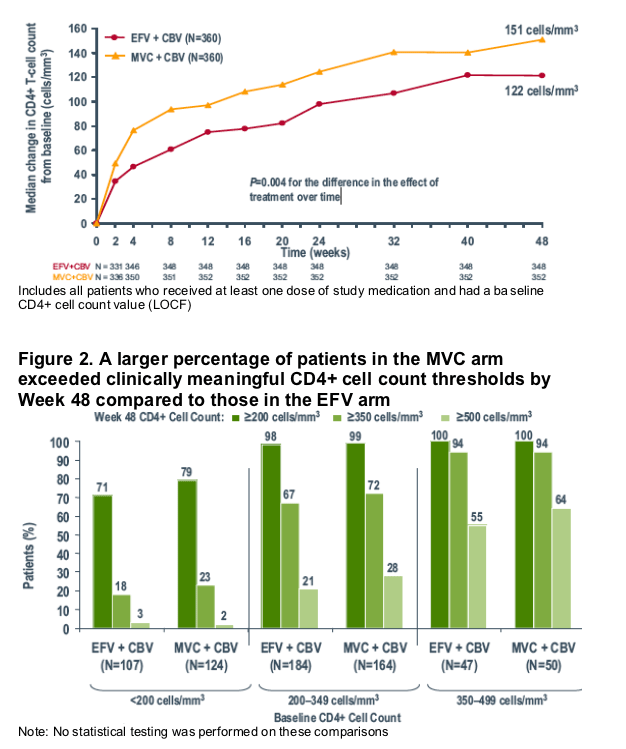
Discordant virologic-immunologic responses
After 6 months of study treatment, more patients in the MVC arm than in the EFV arm experienced concordant responses to study treatment, according to thresholds of <400 copies/mL for virologic response and >100 cells/mm3 increase in CD4+ cell count from baseline for immunologic response (Figure 3).
Among virologic responders a higher proportion of patients in the EFV arm experienced a discordant immunologic response vs those in the MVC arm (Figure 3).
The percentage of patients achieving <400 copies/mL who did not experience a >100 cells/mm3 increase in CD4+ cell count from baseline was 36% for the EFV vs 29% for the MVC arm.
Similar results were seen when response rates were observed for patients achieving <50 copies/mL who did not experience a >50 cells/mm3 increase in CD4+ cell count from baseline; P<0.001).
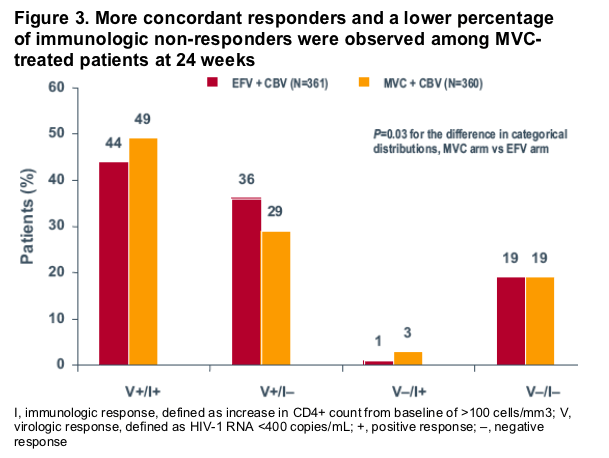
An early increase in median CD8+ cell count was observed in the MVC arm, which subsequently declined back towards baseline at Week 16 through to Week 48 (Figure 4). In contrast, a gradual decline in CD8+ cell counts was observed from baseline in the EFV arm, with a median change at Week 48 of -110 cells/mm3.
At Week 48, there was an increase from baseline in CD4% (CD4+ cell count as a percentage of the total lymphocyte count) of similar size in both treatment groups (mean of +8.1% and +9.5% in the MVC and EFV treatment groups, respectively).
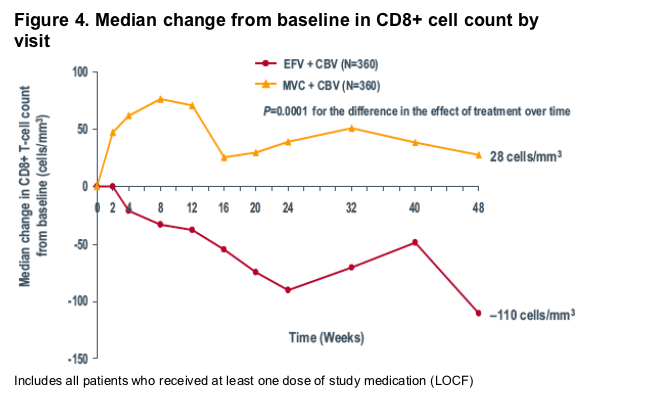
Predictors of CD4+ cell count increases
A multivariate regression model of predictors of Week 48 CD4+ cell count increases from baseline identified significant associations with:
Baseline CD4+ cell count: Higher baseline CD4+ cell counts were associated with greater increases in CD4+ cell count (P=0.0005).
Week-48 change in HIV-1 RNA level: Larger decreases from baseline in HIV-1 RNA at Week 48 were associated with greater increases in CD4+ cell count (P<0.0001).
Treatment arm: Patients randomized to MVC + CBV experienced greater increases in CD4+ cell count than those randomized to EFV + CBV (P<0.0001).
Variables found not to be associated with Week 48 CD4+ cell count increase were age, gender, and baseline HIV-1 RNA level.
Predictors of Category C events
As previously reported, twice as many patients in the EFV arm vs the MVC arm experienced a Category C event on treatment (12 [3.3%] vs 6 [1.7%], respectively).7
Figure 5 shows a Kaplan-Meier plot of time to Category C event occurrence.
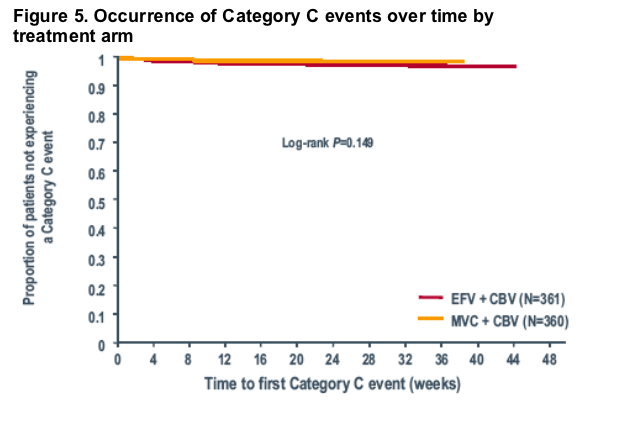
Three significant factors associated with time to Category C event occurrence (Cox proportional hazard modeling) were identified:
On-treatment CD4+ cell count (per 50 cells/mm3 increase from baseline): HR=0.8 (P=0.040).
Baseline HIV-1 RNA level (per log higher): HR=2.4 (P=0.030).
Achieving an HIV-1 RNA <50 copies/mL by Week 48: HR= 0.08 (P<0.0001).
Longer time to Category C event was associated with lower baseline HIV-1 RNA level, higher CD4+ cell counts on treatment, and achieving <50 HIV-1 RNA copies/mL by Week 48.
Baseline CD4+ cell count, age, and gender were not significant predictors of time to Category C event in the multivariate model.
In a univariate analysis, treatment arm was not significantly associated with the time to Category C event (P=0.149). However, among patients who did not achieve HIV-1 RNA <50 copies/mL at Week 48, fewer MVC recipients (1/104 [1%]) developed a Category C event compared to EFV recipients (7/75 [9%]; P=0.007). The median (IQR) CD4+ cell count changes from baseline in these non-responder subgroups were 64 (4.5, 142.5) and 0 (-7.75, 76.5) cells/mm3, respectively.
When treatment arm was included in the multivariate model, MVC treatment was associated with longer time to development of a Category C event, in addition to baseline HIV-1 RNA level, on-treatment CD4+ cell count, and achieving HIV-1 RNA <50 copies/mL at Week 48.
REFERENCES
1. Monforte A, et al. AIDS 2008; 22:2143-2153.
2. Lewden C, et al. J Acquir Immune Defic Syndr 2007; 46:72-77.
3. Grabar S, et al. Ann Intern Med 2000; 133:401-410.
4. Tan R, et al. J Acquir Immune Defic Syndr 2008; 47:553-558.
5. Baker JV, et al. AIDS 2008; 22:841-848.
6. Baker JV, et al. J Acquir Immune Defic Syndr 2008; 48:541-546.
7. Saag M, et al. 4th IAS Conference on HIV Pathogenesis, Treatment and Prevention. Sydney, Australia, 22-25 July 2007; Abstract WESS104
|
| |
|
 |
 |
|
|